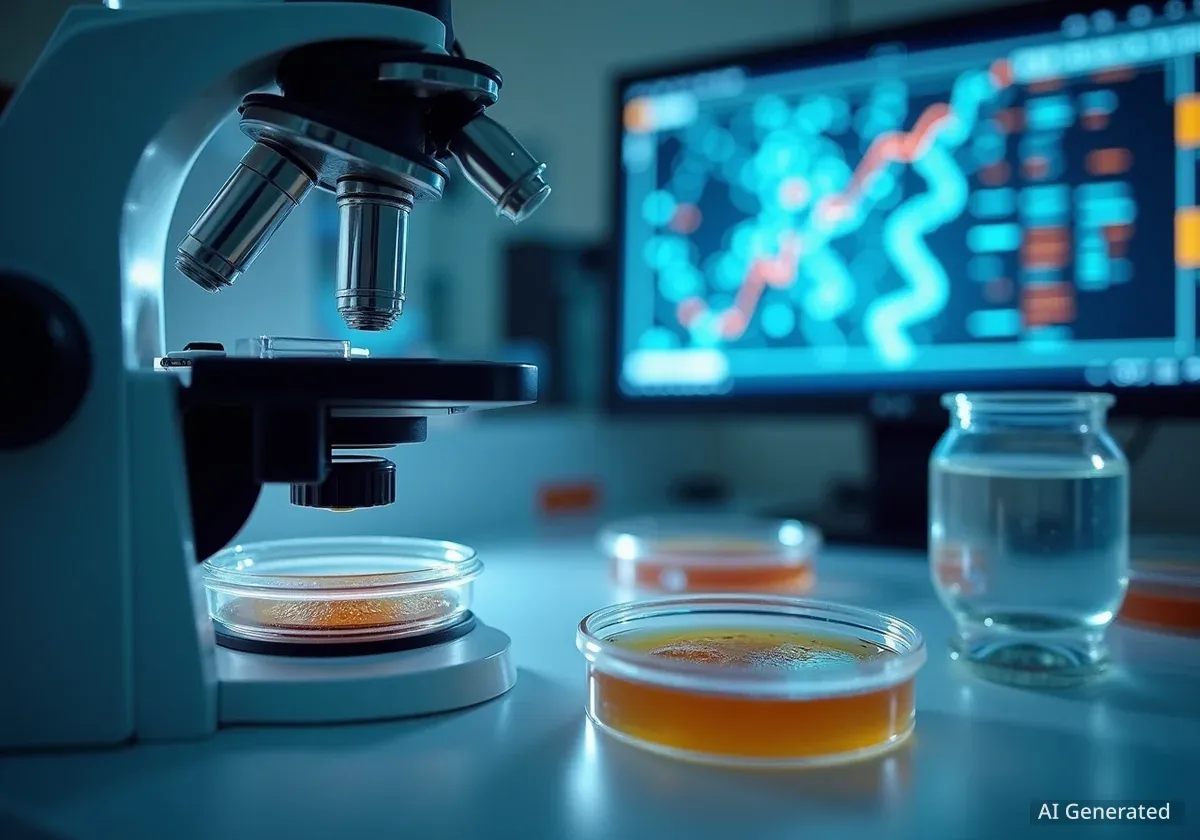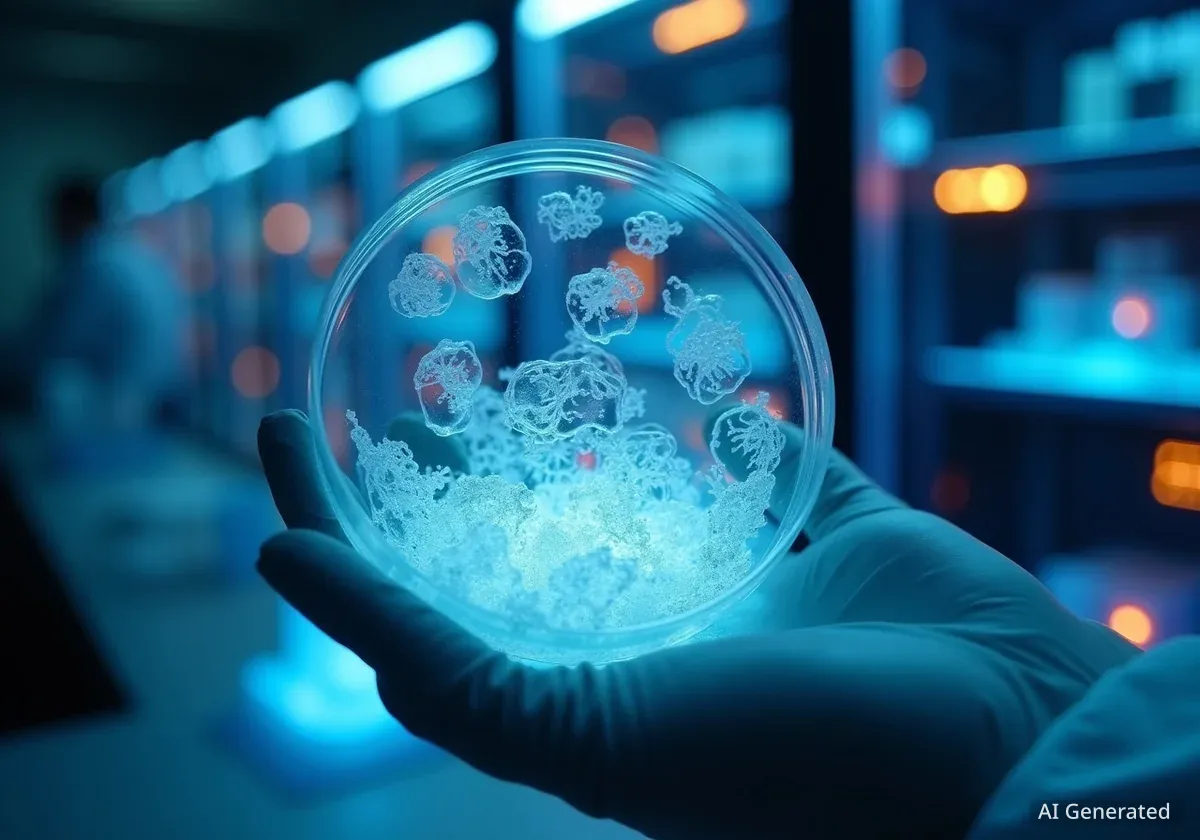Researchers from Google and Yale University have developed a new artificial intelligence model that identified a potential method for making cancer tumors more visible to the body's immune system. The AI's prediction, which involves an existing drug, has been successfully validated in laboratory experiments, opening a new avenue for developing cancer treatments.
The 27 billion-parameter model, named C2S-Scale 27B, was designed to analyze the complex behavior of individual cells. It successfully generated a novel hypothesis about how to amplify immune signals in tumors, a key challenge in cancer immunotherapy.
Key Takeaways
- Google and Yale University released C2S-Scale 27B, a 27 billion-parameter AI model for single-cell analysis.
- The AI predicted that the drug silmitasertib could boost a tumor's visibility to the immune system when combined with low levels of interferon.
- This prediction was a novel hypothesis, not previously documented in scientific literature.
- Laboratory experiments on human cells confirmed the AI's prediction, showing a synergistic effect that increased antigen presentation by approximately 50%.
- The discovery provides a promising lead for developing new combination therapies to treat "cold" tumors, which are typically unresponsive to immunotherapy.
A New AI Tool for Cellular Biology
The development of C2S-Scale 27B marks a significant step in applying large-scale AI to biological research. Built upon Google's Gemma family of open models, it was created as part of a research collaboration aimed at understanding the intricate language of cells.
A central challenge in modern oncology is that many tumors are considered "cold," meaning they effectively hide from the body's immune system. A primary goal of immunotherapy is to make these tumors "hot," forcing them to display signals that attract an immune response. This process is known as antigen presentation.
According to the research team, their work demonstrates that larger AI models do not just improve at existing tasks but can acquire new capabilities, such as generating entirely new scientific ideas. The discovery of this potential cancer therapy pathway supports the idea that scaling AI models can lead to breakthroughs.
What Are 'Cold' and 'Hot' Tumors?
In cancer immunotherapy, tumors are often categorized based on their interaction with the immune system. 'Hot' tumors are those that have been infiltrated by T-cells, a type of immune cell that can kill cancer cells. 'Cold' tumors lack this T-cell infiltration and are therefore invisible or unresponsive to the immune system. A major goal of modern cancer research is to find ways to convert 'cold' tumors into 'hot' ones, making them susceptible to immunotherapy treatments.
The AI's Task and Prediction
Researchers tasked C2S-Scale 27B with a complex problem: find a drug that could act as a conditional amplifier. The goal was to identify a compound that would boost immune signals only within a specific environment where low levels of interferon—a key immune-signaling protein—were already present but not strong enough to trigger antigen presentation on their own.
To achieve this, the team designed a virtual screen using two distinct scenarios:
- Immune-Context-Positive: The model was given data from real patient samples where tumor-immune interactions and low-level interferon signaling were present.
- Immune-Context-Neutral: The model was given data from isolated lab-grown cell lines that lacked any immune context.
The AI simulated the effects of over 4,000 drugs in both contexts. It was specifically instructed to find drugs that enhanced antigen presentation only in the first, more patient-relevant scenario. This required a level of conditional reasoning that smaller models were unable to perform.
A Novel Discovery
The model identified a kinase CK2 inhibitor called silmitasertib (CX-4945). While this drug was known to be involved in various cellular functions, its ability to enhance antigen presentation in this specific context had not been previously reported in scientific literature. This demonstrated that the AI was generating a new, testable hypothesis rather than just retrieving existing knowledge.
From AI Hypothesis to Lab Validation
The model's most compelling prediction centered on silmitasertib. It forecasted a strong increase in antigen presentation when the drug was used in the "immune-context-positive" setting but predicted little to no effect in the neutral context. This novel idea required experimental validation to prove its value.
The research team took this hypothesis to the lab, testing it on human neuroendocrine cell models—a type of cell the AI had never encountered during its training. The results from the laboratory experiments directly confirmed the AI's predictions.
"The model’s in silico prediction was confirmed multiple times in vitro," the researchers stated. "C2S-Scale had successfully identified a novel, interferon-conditional amplifier, revealing a new potential pathway to make 'cold' tumors 'hot.'"
The lab tests produced clear results:
- Treating cells with silmitasertib alone had no effect on antigen presentation.
- Treating cells with a low dose of interferon alone produced only a modest effect.
- When combined, silmitasertib and low-dose interferon created a powerful synergistic effect, amplifying antigen presentation.
Remarkably, the combination treatment resulted in an approximate 50% increase in antigen presentation. This would theoretically make the tumor significantly more visible and vulnerable to an attack by the immune system.
Implications for Future Cancer Treatment
This successful validation provides a strong, experimentally-backed lead for developing new combination therapies for cancer. By using multiple drugs in concert, treatments can achieve a more robust and targeted effect. The pathway uncovered by C2S-Scale 27B could help make previously unresponsive tumors treatable with immunotherapy.
The project also serves as a blueprint for a new form of biological discovery. It shows that large-scale AI models can run high-throughput virtual screens, understand context-dependent biology, and generate scientifically-grounded hypotheses that can be tested in the real world.
Teams at Yale are now investigating the underlying mechanism of this interaction and are testing other AI-generated predictions. While further preclinical and clinical validation is required, such AI-driven hypotheses could significantly accelerate the development of new therapies.
To encourage further research, the C2S-Scale 27B model, its code, and related resources have been made publicly available to the scientific community on platforms like Hugging Face and GitHub.





